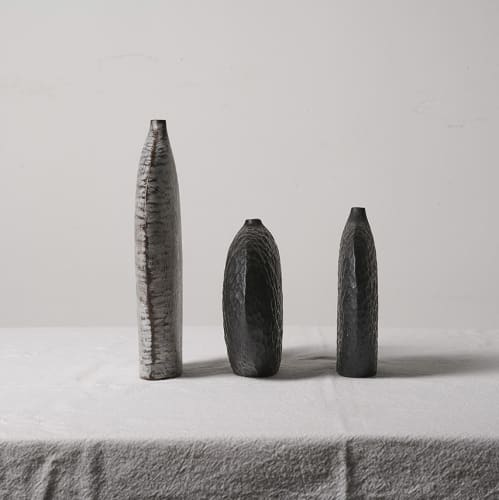Mok-su South Korean, b. 1973
“(The) working process is a like mind…I let go of all the large machines to simplify this process, now I use only hand tools and try to keep mywork small and low”
Known only by his chosen name, Mok-su has embraced woodcarving as a meditative practice, a means of quieting his restless mind. Originally trained as a classical musician, he was forced to leave music behind to support his inventor father’s business in Poland. It was there that he first picked up woodworking—not as an art form, but out of necessity—to craft a classical guitar for himself. Yet, in the process of shaping wood, he discovered something profound: a sense of peace, focus, and mindfulness in the solitary act of making.
Upon returning to South Korea, Mok-su continued working with wood, but soon grew disillusioned with modern, mechanized production. He rejected machinery, seeing in it the erasure of the human touch, and instead committed himself entirely to hand tools. His practice became slower, more physically demanding, yet deeply liberating—an antidote to the dehumanizing nature of contemporary work. Woodcarving, for him, is no longer just about creation, but about being present in every cut, every mark, every moment.
Each of Mok-su’s works bears the traces of this devotion. Countless gouge marks cover the surface, forming intricate lines and planes that shape the body and foot of each piece. He never sketches or pre-plans, allowing his meditative state to guide the form into being. Even the smallest works take days to complete, their subtle variations revealing his pursuit of neither perfection nor imperfection—only presence.
Further engaging with nature, Mok-su creates his own pigments, extracting color from charcoal, chalk, earth, indigo, herbs, seashells, Korean calligraphy ink, and minerals. Applied through techniques such as burning, brushing, rubbing, polishing, and scorching, these natural hues enhance the organic textures of his carvings. The result is often mistaken for other materials—leather, marble, or artifacts unearthed from the deep woods—inviting viewers to rediscover the quiet wonder of the material world.
-
 Legged Tea Table - LargeView more details
Legged Tea Table - LargeView more details -
 Black Low Tea Table, 2021View more details
Black Low Tea Table, 2021View more details -
 Long Footed Tea Table, 2021View more details
Long Footed Tea Table, 2021View more details -
 Three Tier Tray, 2021View more details
Three Tier Tray, 2021View more details -
 Blade Tea Table, 2022View more details
Blade Tea Table, 2022View more details -
 Emptying series, 2022View more details
Emptying series, 2022View more details -
 Everyday Object - Tray, 2022View more details
Everyday Object - Tray, 2022View more details -
 Footed Round Tea Table - Large, 2022View more details
Footed Round Tea Table - Large, 2022View more details -
 Breath #4, 2023View more details
Breath #4, 2023View more details -
 Breath #6, 2023View more details
Breath #6, 2023View more details
-

Collect
Fair 28 Feb - 2 Mar 2025Lloyd Choi Gallery at Collect 2025 Lloyd Choi Gallery is proud to present a curated selection of works by seven exceptional Korean artists, each showcasing the rich heritage and innovative spirit of Korean art and design. Among them, Minwook Kim, a Loewe Craft Prize finalist, unveils his groundbreaking ceramics, while...Read more -

Guided by Nature
Exhibition 7 - 17 Oct 2024A synergistic exhibition showcasing the finest South Korean craftmanship from Gallery Lloyd Choi, set against the backdrop of Cox London’s nature-inspired, sculptural collection of lighting, furniture, and objects. This partnership honours the flow state harnessed by craftspeople guided by the wisdom of nature. Cox London creations emerge from a state...Read more -

Hidden Gem
Exhibition 15 - 19 May 2024Often, beauty is discovered in the simplicity and serenity of small details. It exists in the nuances of craftsmanship and the precision of execution. ‘Hidden Gem’ presents Korean artists who demonstrate the subtlety of Korean craft, centring their practice around materiality and process. During the last imperial dynasty of Korea...Read more -

Collect
Fair 1 - 3 Mar 2024At Collect 2024, Lloyd Choi Gallery presents ‘Understatement ’, a highly curated presentation of works by nine Korean craft practitioners to mark the 20th anniversary of the international art fair for contemporary craft and design. The presentation explores a distinctive style in Korean craft and design that refined during the...Read more -

Untold Beauty
Exhibition 16 - 24 Sep 2023Untold Beauty draws on a distinctive period in Korean craftsmanship refined during the Joseon dynasty (est 14c). Presenting works by contemporary practitioners, it explores the current return to Joseon’s contemplative aesthetic: featuring ceramics, furniture, textile, and woodworwk including the Moon Jar. Clean, non-decorative and functional everyday objects were made and...Read more -

Collect
Fair 1 - 5 Mar 2023For Collect 2023, Lloyd Choi Gallery will focus on the new generation of ceramic artists and introduce two European- based Korean artists, exhibiting in London for the first time. Yusun Won, living and working in Cardiff and Lydia SJ Park based in Oslo. Both have already achieved international recognition for...Read more -

Korean Blue
Exhibition 2 - 6 Nov 2022Unlike Yves Klein, the colour blue was a hue that meant home to the pioneering Korean painter Kim Whan-gi who moved to Paris in the 1950s and became the father of the Korean abstract art movement. Its purity, transparency and tranquillity reflect the virtue of Korean traditions that played a...Read more -

Silent Mind
Exhibition 14 - 25 Sep 2022The exhibition title reflects the calm and mindful status of the craft-artists Lloyd Choi Gallery works with, whose practices are hands-on and materials-led. These Korean artists and makers, working with natural materials, hold a focus on process and understanding the laws of nature – choosing to work with these, rather...Read more



















